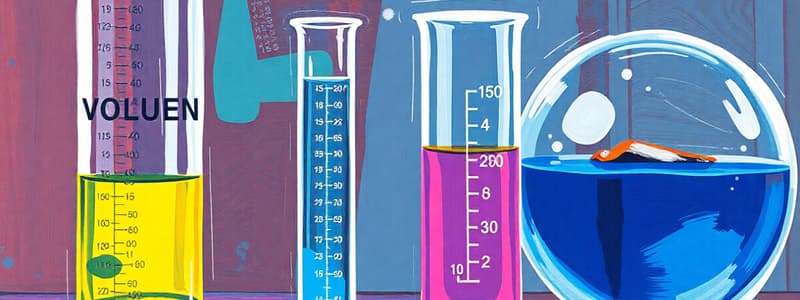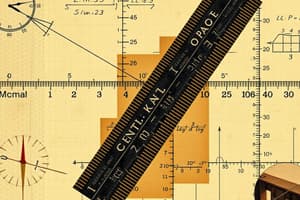Podcast
Questions and Answers
What is the SI base unit of length?
What is the SI base unit of length?
- Foot
- Yard
- Centimeter
- Meter (correct)
Which of the following is true regarding volume measurements?
Which of the following is true regarding volume measurements?
- 1 mL is equivalent to 10 m³.
- Volume is measured only in liters.
- The SI unit of volume is the cubic centimeter.
- 1 liter is equivalent to 1 dm³. (correct)
What is the primary use of volumetric flasks in a laboratory?
What is the primary use of volumetric flasks in a laboratory?
- To transfer volumes of liquids.
- To contain liquids without measuring.
- To measure specific volumes accurately. (correct)
- To heat substances evenly.
Which of the following measuring devices is primarily used for transferring measured volumes?
Which of the following measuring devices is primarily used for transferring measured volumes?
What are common quantities that should be measured accurately in chemistry?
What are common quantities that should be measured accurately in chemistry?
Flashcards
SI unit of length
SI unit of length
The meter (m).
Volume definition
Volume definition
The space occupied by matter.
SI unit of volume
SI unit of volume
Cubic meter (m³).
Common volume units
Common volume units
Signup and view all the flashcards
Volumetric flask use
Volumetric flask use
Signup and view all the flashcards
Study Notes
Introduction to Measurements
- Chemistry relies on precise measurements of various physical quantities
- These quantities include length, volume, mass, time, density, and temperature
- Accurate and consistent measurements are crucial for scientific experiments and calculations
Units of Measurement
- The SI (International System of Units) is the standard system used
- The base unit of length is the meter (m)
- Other units, like centimeters (cm), millimeters (mm), and micrometers (µm) and nanometers (nm) are also in use, and their conversions to meters
- A yard is a little longer than a meter (1m = 1.094 yd)
- A centimeter is about two-fifths of an inch (1 cm = 0.3937 in)
- An inch is about 2.54 centimeters (1 in = 2.54 cm)
- The angstrom (A), micrometer (µm), nanometer (nm), and picometers (pm) are used as smaller units
Volume
- Volume is the amount of space occupied by a substance
- The Sl unit of volume is the cubic meter (m³)
- In chemistry, liters (L) and milliliters (mL) are also used
- Liter (L) = 1 cubic decimeter (dm³) = 10-3 m³
- 1 milliliter (mL) = 1 cubic centimeter (cm³) = 10-3 dm³ = 10–6 m³
- A relationship exists between length and volume, volume can be calculated by multiplying the length, width and height
- Measurement of volume using glassware like Erlenmeyer flasks, beakers, graduated cylinders, pipets, and burets for different laboratory purposes
Laboratory Techniques
- Erlenmeyer flasks are used to hold liquids
- Beakers are used to hold liquids and make mixtures
- Graduated cylinders are used to measure volumes precisely
- Pipettes and burets are used for transferring precise amounts of liquids
- Volumetric flasks are used to prepare solutions of exact concentrations
Studying That Suits You
Use AI to generate personalized quizzes and flashcards to suit your learning preferences.




